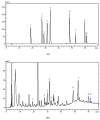Effect of Methyl Jasmonate on Phenolic Accumulation in Wounded Broccoli
- PMID: 31574924
- PMCID: PMC6804049
- DOI: 10.3390/molecules24193537
Effect of Methyl Jasmonate on Phenolic Accumulation in Wounded Broccoli
Abstract
In order to find an efficient way for broccoli to increase the phenolic content, this study intended primarily to elucidate the effect of methyl jasmonate (MeJA) treatment on the phenolic accumulation in broccoli. The optimum concentration of MeJA was studied first, and 10 μM MeJA was chosen as the most effective concentration to improve the phenolic content in wounded broccoli. Furthermore, in order to elucidate the effect of methyl jasmonate (MeJA) treatment on phenolic biosynthesis in broccoli, the key enzyme activities of phenylpropanoid metabolism, the total phenolic content (TPC), individual phenolic compounds (PC), antioxidant activity (AOX) and antioxidant metabolism-associated enzyme activities were investigated. Results show that MeJA treatment stimulated phenylalanine ammonia-lyase (PAL), cinnamate 4-hydroxylase (C4H), and 4-coumarin coenzyme A ligase (4CL) enzymes activities in phenylpropanoid metabolism, and inhibited the activity of polyphenol oxidase (PPO), and further accelerated the accumulation of the wound-induced rutin, caffeic acid, and cinnamic acid accumulation, which contributed to the result of the total phenolic content increasing by 34.8% and ferric reducing antioxidant power increasing by 154.9% in broccoli. These results demonstrate that MeJA in combination with wounding stress can induce phenylpropanoid metabolism for the wound-induced phenolic accumulation in broccoli.
Keywords: antioxidant capacity; methyl jasmonate; phenolic accumulation; phenylpropanoid metabolism; wounded broccoli.
Conflict of interest statement
The authors declare no conflict of interest.
Figures










References
-
- Jeffery E.H., Brown A.F., Kurilich A.C., Keck A.S., Matusheski N., Klein B.P., Juvik J.A. Variation in content of bioactive components in broccoli. J. Food Compos. Anal. 2003;16:323–330. doi: 10.1016/S0889-1575(03)00045-0. - DOI
MeSH terms
Substances
Grants and funding
LinkOut - more resources
Full Text Sources

